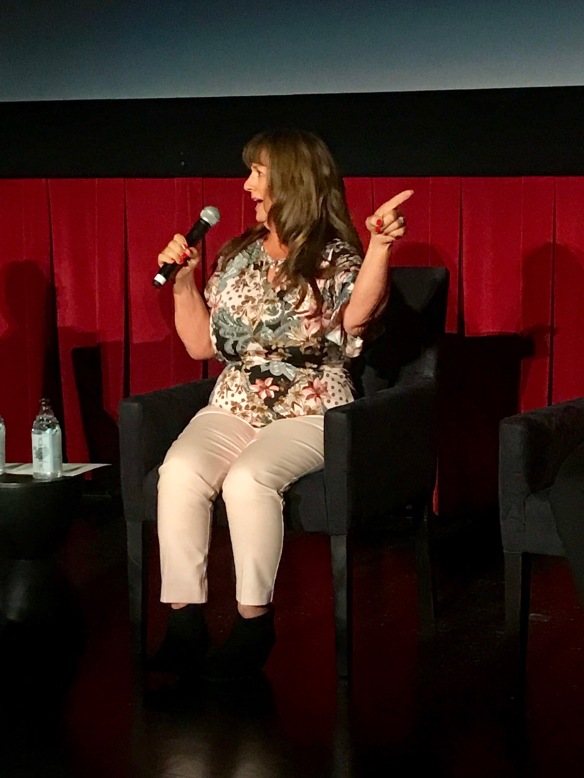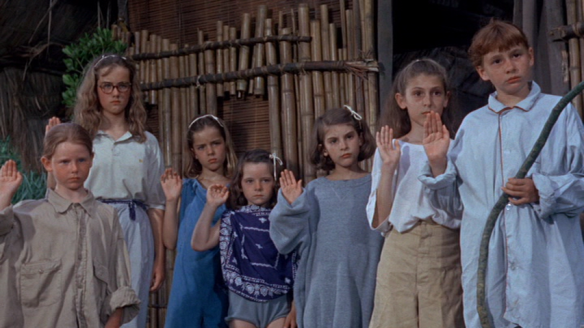B movies once landed Eddie Muller in trouble—with a noir dame, no less.
At the launch party for his 2001 book Dark City Dames, he’d assembled such screen veterans as Jane Greer, Ann Savage, Audrey Totter, and Evelyn Keyes. “When I had them all together,” Muller remembers, “at some point I said, ‘And they all cut their teeth making B films…’ And Evelyn Keyes just looked daggers at me, grabbed the microphone, and said, ‘I never made a B movie.’”
Keyes’s fiery reaction suggests how much baggage the term B movie carried within the studio system. “I had to backtrack, because Evelyn started at the top,” Muller says.
In retrospect, however, he points out that the timely 1948 virus outbreak noir The Killer That Stalked New York, starring Keyes, teeters on the edge of the B realm. “They spent some money making that film, but it’s 80 minutes long, I’m sure that it got a release as an A picture, but probably quickly hit the circuit in the bottom half of double bills.”
As Muller notes, “It’s hard to determine these things, because you don’t know unless you look at the interoffice memos at the studios and see how they were selling it. Or newspapers of the day are great, because you can see: What was the double bill? What was on the bottom half of the double bill?”
Indeed, a quick search of newspapers shows that by 1951 The Killer That Stalked New York, its release delayed due to similarities with Panic in the Streets, was being advertised as a supporting feature for such movies as King Solomon’s Mines, Kansas Raiders, Grounds for Marriage, and, most eerily, Lullaby of Broadway.
Over Zoom I sat down with the Film Noir Foundation founder, TCM host, and author of the recently re-released Dark City to discuss some of his favorite B crime flicks and the importance of B movies in general.

To start off, how should film fans define a “B movie”?
EM: I always have to advise people to be careful of how they classify B movies. Technically a B movie was made for the bottom half of a double bill, and it had to fit certain requirements in terms of length. Because of that, fewer resources were given to the B movies than A movies.
They were almost entirely genre pictures: a B Western or a B crime picture or a B jungle story or adventure story. So there’s an interesting corollary between genre fiction, like you would see in pulp magazines, and B movies. And people’s attitudes about them are somewhat similar. Like genre fiction isn’t taken as seriously as literature. A movies are A Place in the Sun and B movies are… Decoy or something like that! Who’s gonna take that movie seriously?
I’m glad that finally at this stage people are starting to understand what a B movie is. When I was growing up there were so many “scholarly” books about the movies that lumped all crime movies in as B films. That’s not the case. Paramount had a B unit, and Double Indemnity was not made in the B unit at Paramount. That’s as A as A gets!
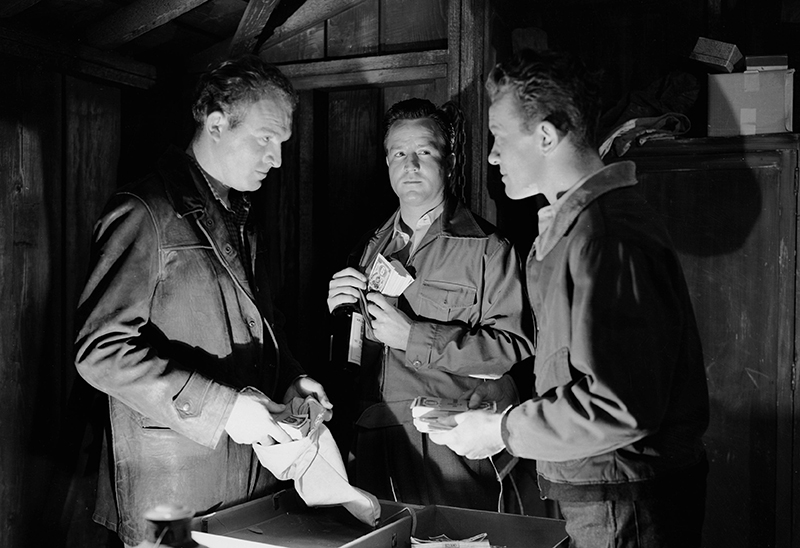
What’s special about B noir?
EM: For more sophisticated film watchers, I think the thing that is so appealing about B movies is that once you know that’s the terrain you’re in, that it’s impoverished to begin with, then you start to really appreciate the creativity that the filmmakers bring to it.
It’s also like sports: the B movies are somewhat the minor leagues and you see a lot of directors learning their craft and making B movies and if they can, with no money, bring something a little more exciting to the material, then they get noticed and they get called up to the big leagues. And watching that is kinda thrilling. That’s what I really enjoy about B movies: seeing people being creative and resourceful with limited means.

To describe films falling in the gray area between A and B, this term of “nervous A” sometimes comes up. How do you distinguish the B from the nervous A?
EM: With a nervous A, it’s my impression that you may be catching actors on the way down. They don’t want to say it’s a B movie. They got somebody with a name, but they weren’t a draw any longer.
Back then when television wasn’t so prevalent, a lot of the nervous As or A pictures that had a shorter running time would be rereleased on the bottom half of a double bill. Whereas later on in the 1950s, it would be sold to television and it wouldn’t have as much of a second life in the theaters.
Sometimes it’s just a subjective thing. Like, this thing just looks really good. They got this cinematographer who was on the cusp of going to A pictures. And you see that at Columbia with B movies shot by Burnett Guffey who would soon be their A cinematographer.
Nervous As are not made by design. That designation is applied after the fact. There are a lot of factors involved.
A classic example of what we’re talking about is Gun Crazy, which began as a King Brothers film at Monogram, and then they wanted to get out of the B rut. So they got MacKinlay Kantor, who wrote The Best Years of Our Lives, to write that, and their expectation was, “We’re making an A picture.” Then Monogram got folded into United Artists, so that it could actually be an A picture by the time it was released. But United Artists screwed up the whole release of the film and it ended up being stuck with this status as a B movie. They pulled it back, and by the time they did release it, it was on the bottom half of double bills, getting much better reviews than the films on the top half of the double bills.
Or all of a sudden they realize that they’ve caught lightning in a bottle, and this actor’s performance is incredible. Like Dillinger with Lawrence Tierney, which was the King Brothers as well. They made this as a B. They spent no money on that. But then they see Tierney’s performance and think, “We can sell this. Let’s put this out as the top half of double bills.” That damn thing ended up nominated for an Academy Award! Kind of amazing for a B film.

Tell me about Film Noir Foundation restorations of B movies. Are these films more at risk and in need of preservation efforts?
EM: It definitely seems that way. And a lot of B movies are not going to be saved, because they slipped through the cracks. Interestingly enough, the noir stuff plays the best for a modern audience, so we’ve been successful saving these movies. But a lot of Westerns are not going to be saved. A lot of jungle movies are not going to be saved. Since there’s so much that’s incorrect in those movies, they wouldn’t be as valued. That plays a big part in it.
A lot of people in the movie business could raise enough money to make a B to get going, but those films, because they’re not produced by a major studio, they’re only distributed by the studio, they become at risk. When those distribution deals have ended, that’s where we go looking, especially when it’s Hollywood noir or American noir, because some of these movies are not made in Hollywood.
It’s all about how they were distributed. A lot of films that we have rescued are independently made films. The Argyle Secrets, our latest restoration, was produced by Film Classics.
I can talk about it now, because I saw the restoration! It turned out great. I never want to talk about a restoration until I actually see it done. It looks better than any B movie has a right to.
Cy Endfield, the director, who was a magician, was so clearly enamoured of this waterfront set they created—that’s a miniature—that he actually does an entire camera move drifting through and around this set with a little toy ship! And when it’s shot in 35mm, you can kind of get away with it, with the lighting and everything. Which is one of the things you have to be careful of when these films are digitized: that you don’t digitize them in too much definition, because then the jig is up. You can see that everything is fake when the definition is too acute.
Endfield wasn’t even trying to hide that it was a miniature, like, “I’m going to do a one-minute tracking shot through this miniature, because somebody spent all the time to make all these little barrels with the ropes around them and the twinkling lights in the background. Great work, guys! We’re gonna exploit this.” I found it very amusing. I love that stuff.
But there’s nobody safeguarding that movie. That’s where we come in. We’ve learned about the life expectancy of these films. If they’re not properly cared for, they will disintegrate.
And without further ado, here are 10 of Eddie’s favorite B crime movies, in chronological order.

The Stranger on the Third Floor (Boris Ingster, 1940)
EM: I have to pick, from 1940, Stranger on the Third Floor, because so many people now want to say, “Oh, that was the beginning! That was the start of it all.” Which isn’t really the case, but it’s such an outrageous example of expressionism used in an otherwise completely B story. There’s no budget or anything in that movie. It’s a true B film. But it hits all of those boxes that we talked about earlier. Immensely creative, so much talent is being shown off in that movie. It’s a great noirish story.
And it allows Peter Lorre and Elisha Cook Jr. to be in the A picture that kicks things off, in The Maltese Falcon, and the B picture. So it’s like the Peter Lorre-Elisha Cook Jr. double bill. You can sort of start the American noir movement with those two.
There were some very heady intellectual contributors to that film. Nathanael West worked on the screenplay. Frank Partos wrote it. Boris Ingster was a disciple of Sergei Einsenstein, and he had all kinds of ideas about cinema that were outside the mainstream. It’s always fun when one of those people gets their hands on the controls, and it’s usually a B movie.
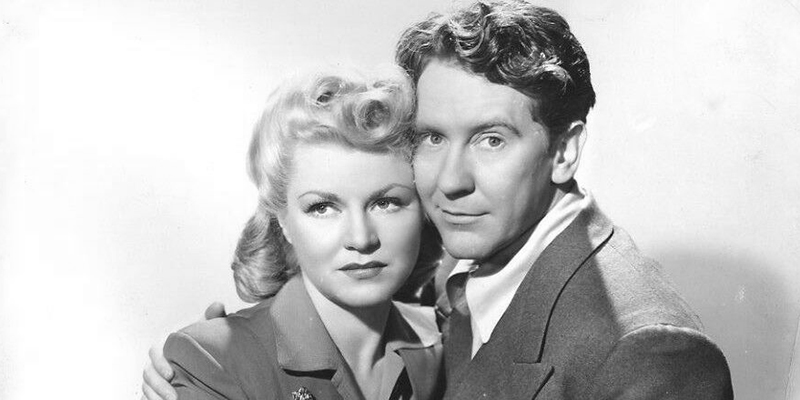
Street of Chance (Jack Hively, 1942)
EM: This Paramount B film is important in the noir scheme of things, because it was the first adaptation of one of Cornell Woolrich’s “Black” novels, The Black Curtain. Amnesia is vitally important to film noir. As Lee Server said, it’s film noir’s version of the common cold.
The thing I always loved about Cornell Woolrich stories is the premise is so great and then he has to explain it. At some point you have to explain what’s actually happening and it never quite works. Here the guy realizes he’s been a different person for three years. He has an accident and you think he’s going to lose his memory in this accident, but instead he regains his memory and realizes, “I used to be somebody else!” Wow, that’s a great setup.
I don’t really associate Claire Trevor with B movies. She had already made Stagecoach and Dead End at this point. But this is pretty much a B movie. Jack Hively, the director, was not a big-time name. It’s not a great Woolrich adaptation by any means, but the film is significant and it has a very grungy B movie quality to it.

Fly By Night (Robert Siodmak, 1942)
EM: I really have to talk about this movie, which I discovered, much like Quiet, Please: Murder!, years ago by booking it without ever having seen it. This was the last great B movie that Robert Siodmak would direct before Joan Harrison brought him in to direct Phantom Lady, and from then on he was an A-list director.
Fly By Night could be my favorite B movie. It’s extremely well-crafted, beautifully photographed by John Seitz before he did Double Indemnity. This film looks totally noir.
It’s sort of a cheap redo of The 39 Steps with Richard Carlson as the Robert Donat character and Nancy Kelly in the Madeleine Carroll role. It is so much fun. It’s very much a Hitchcock-style film. An innocent man gets thrown into this intrigue with spies and then he’s on the run.
The interplay between Richard Carlson and Nancy Kelly is everything you want in a B movie, where he rips off the bottom of her dress. Like in The 39 Steps, they’re constantly shoved into these close quarters in a very sexy way. I’d only really seen Nancy Kelly as the mother in The Bad Seed, and this movie kind of took me by surprise, how utterly charming she is and what a great comedienne she is.
I’m proud of the fact that I’m the only person who’s shown this movie in the past 25 years or something. I don’t know what the deal is. There’s one print at Universal, and I have to stop showing it at a certain point because I’m the guy who’s going to wear this film out!
But somebody needs to digitize this and get it out on Blu-ray. For God’s sake, it’s a Robert Siodmak film! And his direction is spot-on. Siodmak, unlike Fritz Lang, can do comedy. He has great timing in this film and his choice of angles to play up the comedy—like something’s happening in the foreground, they can’t see what’s going on in the background—and that whole scene on the car carrier is masterful.
I don’t want to keep talking about it, because people can’t see it. I’m going to campaign to have that shown at the next TCM Classic Film Festival…
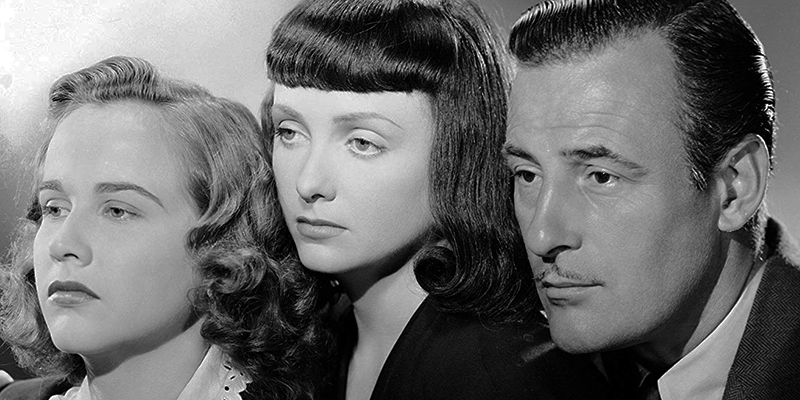
The Seventh Victim (Mark Robson, 1943)
EM: You have to have a Val Lewton on here, so it’s going to be The Seventh Victim, which is a film that I dearly love because it’s a horror-noir hybrid. I can’t for the life of me figure out why people ask me, “Is it noir?” Because of course it’s noir! It’s about a bunch of devil worshippers, but it’s not like Curse of the Demon where suddenly the demon appears at the end of the film. These are just a bunch of crazy people in Greenwich Village who have their weird secret society.
There are set pieces in that movie that are just as good as it gets in a B film. The walk into darkness, where the detective walks into the perfume factory and disappears into darkness. The stuff with Jean Brooks on the street being followed. And the ending of that movie is one of my favorite creepy endings in cinema. It’s all done in this incredibly sophisticated, arty way that you don’t see in a lot of B films. Val Lewton was an absolute genius, and credit to Mark Robson and Nicholas Musuraca, who photographed it. And Kim Hunter gives a great performance.

Destiny (Julien Duvivier and Reginald Le Borg, 1944)
EM: I’m going to try not to say too much about this, because it’s like a secret film of mine. It stars Gloria Jean, who was Universal’s backup to Deanna Durbin. It’s a totally bizarre film, but the history makes it even weirder. The movie itself is about a crook who comes into a small rural town and is taken in by a farmer and his blind daughter. The crook is going to steal from them, but the girl is so good, so pure, like beyond Snow White pure, that nature comes to her rescue and gets even with the guy who’s doing these horrible things. I’m making it sound silly, but the original version of this film was so dark.
It was originally part of another film: Flesh and Fantasy, released the year before, which had big stars. It’s an anthology film of beautifully connected stories about fate and “Does the supernatural exist?” and all this kind of stuff. This story about the blind girl was part of Flesh and Fantasy, but Universal executives thought it was too weird, and they cut it off to make it a separate B movie. But it wasn’t long enough to be a movie so they concocted a whole story about the crook, played by Alan Curtis, that’s directed by somebody else.
So Flesh and Fantasy was directed by Julien Duvivier, the great French stylist, and the second half of Destiny is him. The first half of Destiny is Reginald Le Borg. And no one is ever going to confuse Reginald Le Borg and Julien Duvivier as directors!
There’s 30 minutes of BS to get to Gloria Jean in this movie. Unfortunately, the way the original film is supposed to end is not how Destiny, the B film, ends. There’s a happy ending in the B film. It is not a happy ending in the original—I mean, it’s happy in the sense that he gets his just desserts. Alan Curti had some guts to play that. You feel so sorry for him in Phantom Lady—and then ahhh! He’s wretched in this movie. It’s fascinating to see how they picked the movie apart, put it back together, and had Reginald Le Borg shoot stuff that softens everything in the B movie.
I have tried my damndest to get Universal to restore Flesh and Fantasy to its original form and put all four stories back. The actual script exists that shows what it was supposed to be like without the goofy framing device of the guys in the men’s club with Robert Benchley. It was a film so far ahead of its time. Like the original Twilight Zone. I really wanted all this to happen while Gloria Jean was still alive, because it crushed her that they did this. She wanted to be in a movie with Barbara Stanwyck and all these great actors. But they cut it up and they dumbed it down and they put it out as a B movie.
It still has a lot of great stuff in it. The special effects at the end of that movie are extraordinary. Duvivier and Gloria Jean were fabulous, convincing you that this was real, that she has this power. They made magic together. The audiences that I’ve shown it to sometimes get a chuckle out of it when the squirrel comes and sits on her shoulder, but it’s kind of amazing. It really is an incredible film. I understand why, when Universal butchered it, that was it, Duvivier left America and said, “If this is the way they make movies in America, forget it. I’m going back to France.” He made a lot more great movies in France, but he could’ve been making those films in America.

Jealousy (Gustav Machatý, 1945)
EM: I write about this Republic picture at some length in the new edition of Dark City. There was no mention of this film in the original edition of the book, because I had not seen it. But we did find a print at the British Film Institute.
The thing that separates Jealousy from other B movies is Gustav Machatý, the director. He was a Czech emigré most famous for directing Ecstasy with Hedy Lamarr, which is this arty porn film of the early 1930s, a really good movie also. Jealousy is the artiest B movie of the time. His direction is so strange.
It’s a murder mystery from a story by Dalton Trumbo. There’s a very strong female character at the center of this. Jane Randolph plays a taxi driver in L.A. Any movie with a female taxi driver, I’m there! It’s the best. This taxi driver’s husband is an angry, embittered writer, a European expat who is unappreciated by the crass, lowbrow Americans.
So this movie has a lot of subtext going on about displaced Europeans in southern California. Hugo Haas is the husband’s best friend. There’s this whole thing about the European subculture in Hollywood, just out of place. It’s the Old World in this New World, and they don’t fit at all. And that’s the director of this film as well.
Machatý uses all kinds of techniques: weird Dutch angles, moving camera when there’s no real need for the moving camera. There are some shots that are in slow motion for no apparent reason. He believed in poetic cinema more than prose cinema. When he’s relying on the visual stuff, it’s ingenious. And then when it’s people talking, he has no grasp of how to handle a conversation. He doesn’t know how to do it! Like, why is the camera looking at that while they’re talking? Whenever there are expository passages of dialogue, he has no interest in it whatsoever.
The relationship between Janet, the taxi driver, and her husband is perhaps a little farfetched, but I don’t know that I’ve seen another film that was more effective in talking about those displaced Europeans who came to America to work in the movie business. It has such a genuine feel of being lost and out of place. Jealousy is one of the few movies that dealt with it directly. And by juxtaposing it with Jane Randolph who is so all-American, like, “Come on, you can do this! Just pull yourself together!”
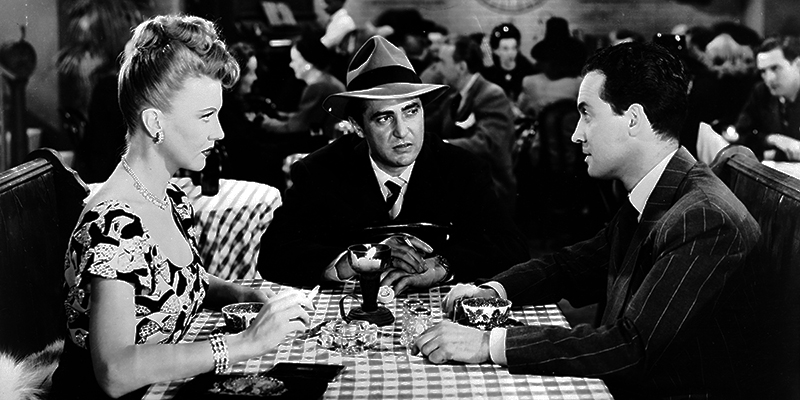
Decoy (Jack Bernhard, 1946)
EM: Speaking of extraordinary female protagonists! Jean Gillie gives Ann Savage a run for her money as the meanest woman in the history of movies. Decoy is a picture that… either I get that thing on Noir Alley in 2022 or I quit! Because I am determined to get that movie seen by more people. It’s just insane. It’s a completely berserk movie.
Jack Bernhard, the director, and Gillie were married. He was a pilot and they met in England during the war. He brought her to Hollywood and this is one of the few films that she made. He directed another film that I really like, The Hunted with Preston Foster and Belita. Those are the two really good noir films on his resume.
If people are unfamiliar with Decoy, all I will say about it is the plot. There’s a gang of criminals and the loot from their heist has been buried, but nobody has the map to where the money is except this guy on death row who’s about to be executed. They have devised a way to resuscitate this man post-execution so that he can lead them to the money.
I’ve shown this film with Stanley Rubin, who wrote the script. Stanley would go on to become a very successful producer. He produced The Narrow Margin. But this is when he was starting out and Decoy was one of his first films. And he had such a good sense of humor about himself and his career that when I said, “Stanley, we want you to be our guest. We’re showing Decoy, ”he was like, “Oh my God! You’re going to show that film?” But he appreciated how great Jean Gillie is in that movie. What a shame that she died so young.
Imagine if they had made a film in which Lawrence Tierney’s character in Devil Thumbs a Ride meets Jean Gillie’s character in Decoy and they go on a crime spree together. That would be unreal. Not gonna see that, but we can dream.

High Tide (John Reinhardt, 1947)
EM: This is a movie that we’ve restored. It’s kind of a newspaper noir. It stars Lee Tracy, who is one of my favorite stars from the 1930s. And it shows how that Lee Tracy character, the ambulance-chasing newshound of the 1930s, became this drunken newspaper guy in the 1940s who is not to be trusted and has no ethics.
One of the things I love about B movies is when you try to tell a super complex story in a limited amount of time, you make jumps in logic. I knew I wanted to restore this movie because of its pedigree. It checked off all my boxes: newspaper movie, gangsters, Lee Tracy. And we’re watching the film and I go, ‘Did we lose a scene? What’s happening? This just jumped forward so far in the plot!’ Then it backtracks, and it all works in the end, but in terms of the narrative structure of the film there’s a point at which you’re wondering, “Where am I? What’s going on in this movie?”
I also love the framing device in that movie, because it’s one of the best ever. Lee Tracy and Don Castle are driving in this car, and it crashes off the coast road into the rocks and then the tide is coming in. And the story is told in flashback as these guys are trapped in the car with the water rising. That is great B movie making right there.
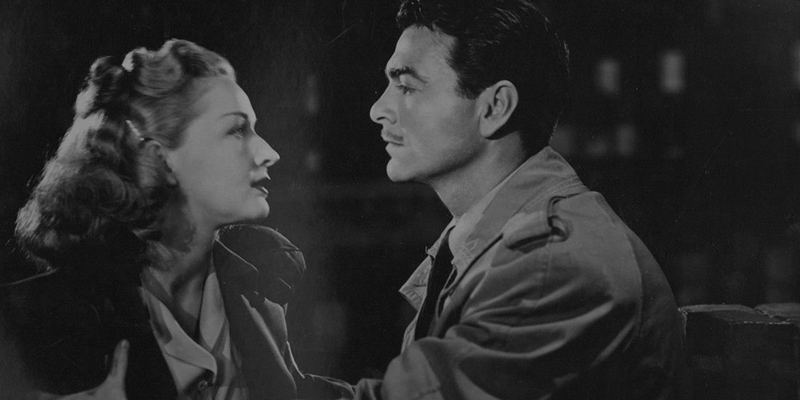
The Guilty (John Reinhardt, 1947)
EM: Obviously I love it, because it’s a film that the Film Noir Foundation restored. It’s based on a short story by Woolrich. This one really captures the feel of his work. Grungy, sweaty, nightmarish. It doesn’t really make a whole lot of sense. And all of that is good.
Bonita Granville plays twins, and this is a long way from Nancy Drew! It’s great to see her playing the bad girl. Of course, if women are twins, one is good and one is bad, right? But there’s this wonderful thing where you lose track of who’s who. And you really don’t know which woman Don Castle is dealing with. It’s part of the weird, nightmarish appeal of this film. You start to question what’s going on in the film. Is this whole thing… just made up?
It’s the ultimate unreliable narrator film. Because Don Castle narrates the whole thing, and at a certain point you start questioning his sanity. I don’t know if this guy is for real or not. When he’s talking about the sisters, they’ve set up the sisters to be antagonists, but you start doubting that. Maybe there isn’t a bad sister. Maybe it’s all in his head, because he’s vying for these women with his buddy, played by Wally Cassell, who’s really great in the film as well.
It’s one of the better Cornell Woolrich adaptations and I’m pleased to say it will be coming out on Blu-ray! As will High Tide.

The Spiritualist, aka The Amazing Mr. X (Bernard Vorhaus, 1948)
EM: This is a bit of a “nervous A,” if you want to call it that. It makes a perfect double bill with Nightmare Alley, because they’re both about charlatans who prey on people thinking that they can see into the future and connect with the spirit world. It has a very charming performance from Turhan Bey as the spiritualist, and two really good actresses: Lynn Bari and Cathy O’Donnell.
John Alton photographed it, and in some respects this may be John Alton’s best work as a cinematographer. It’s directed by Bernard Vorhaus. They actually worked together in Argentina in the 1930s, and Bernard Vorhaus was the guy who essentially brought John Alton to Hollywood. The cinematography in this is magic.
It’s written by Crane Wilbur, who was the king of prison movies, but he was also obsessed with magic and hucksterism and tricking people. He loved the mechanics of tricking people. That’s what this movie is all about, how this guy cons his way into the lives of these two women and convinces them that he can communicate with the dead husband. It exposes all of that, pulls back the curtain in a very entertaining way.
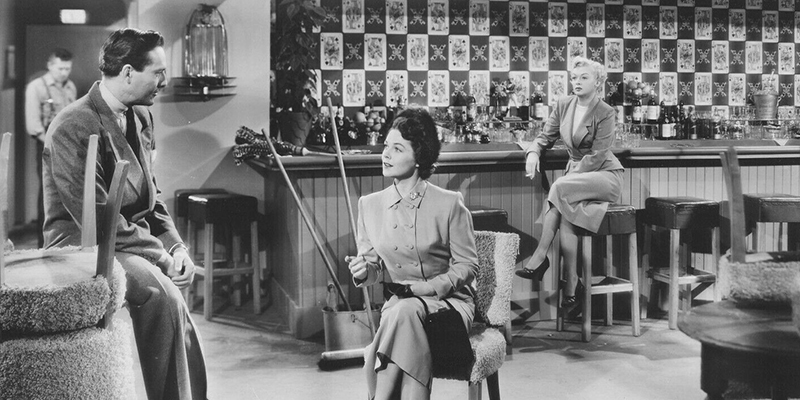
Destination Murder (Edward L. Cahn, 1950)
EM: I have to pick one movie by Edward L. Cahn, who’s like one of the most prolific directors in history, but nobody talks about him. He was a workhorse. He could make bad movies, but he just made movies! And some of them are extraordinary. Some of the movies he made in the early 1930s, you would’ve thought that this guy would become one of the great directors of all time, but no.
Destination Murder one of those movies that could just be totally dreck, just nothing, but you can always count on Cahn to put something goofy in the movies that made them special, whether that was him or the writers. Don Martin was pretty good at writing creative B stuff. Like Stanley Clements as the hit man who kills the guy during intermission of the movie at the beginning of the film. And then you have Albert Dekker and Hurd Hatfield as the two crooks who have this very strange relationship. “Armitage says this! Armitage says that!” No character in the history of movies has referred to himself more in third person. “Moonlight Sonata” figures prominently in the film. The whole thing with the player piano is just nuts.
Joyce Mackenzie is really pretty good. I’m seeing a pattern here: a lot of films with female protagonists, like Margaret Tallichet in Stranger on the Third Floor, Kim Hunter in The Seventh Victim, Jane Randolph in Jealousy… so that’s interesting to note. That was not something I was looking out for when I was making this list, but there you have it!
Where can you find the movies? Half of them are currently available to legally purchase or view in Region 1.
- The Stranger on the Third Floor is available to buy for online streaming or as a Warner Archive DVD
- The Seventh Victim is available to buy for streaming.
- Decoy is available to buy as a Warner Archive DVD.
- The Spiritualist is in the public domain and available for free on YouTube.
- Destination Murder is available to buy as a Warner Archive DVD.
As for the rest, well, you’ll have to go into some dark corners of the internet to find ’em outside of a film festival…




















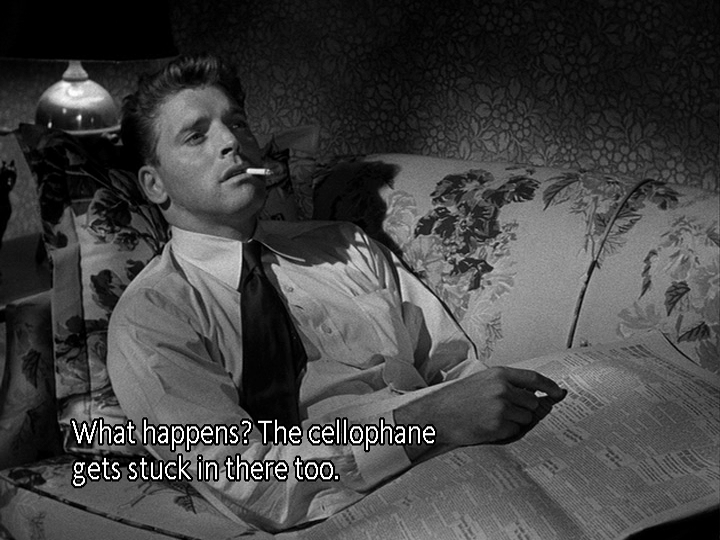
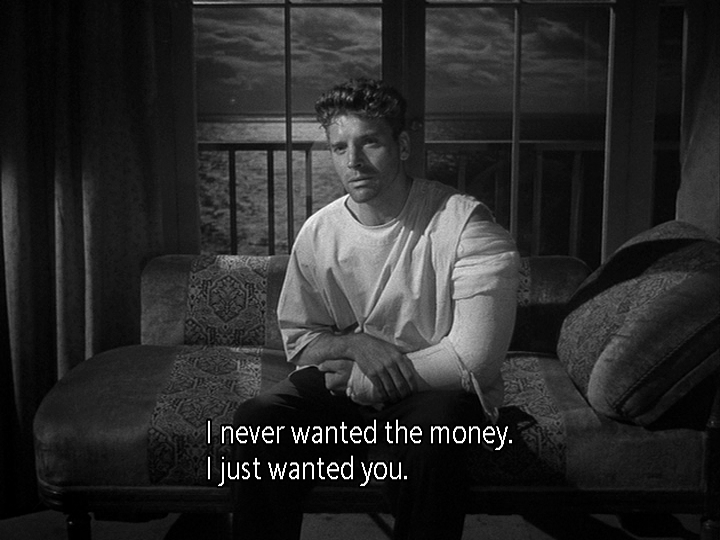






 Philip Marlowe striking a match on Cupid’s stony butt cheeks in Murder, My Sweet rather neatly sums up film noir’s irreverence towards the more delicate notions of love. Go home, arrow boy. You’d better come packing heavier artillery in this part of cinema.
Philip Marlowe striking a match on Cupid’s stony butt cheeks in Murder, My Sweet rather neatly sums up film noir’s irreverence towards the more delicate notions of love. Go home, arrow boy. You’d better come packing heavier artillery in this part of cinema.

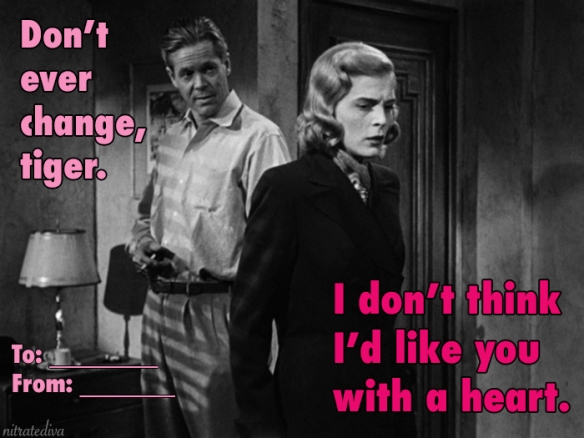




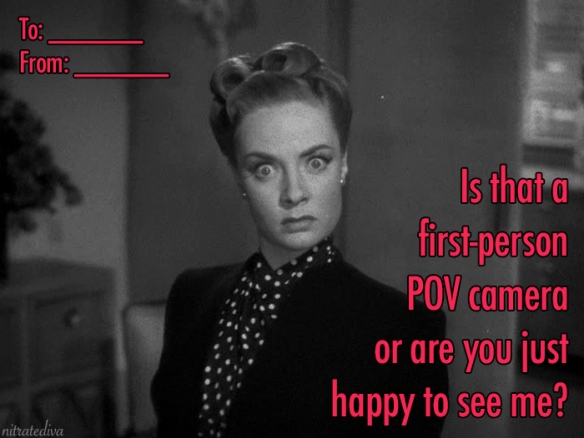


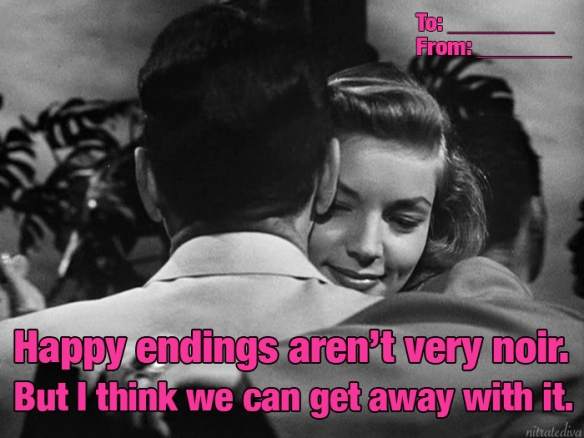




 The Greeks had a word for it: pharmakon. A poison which may also be a cure. A cure which may also be a poison. Plato associated the term with writing, and
The Greeks had a word for it: pharmakon. A poison which may also be a cure. A cure which may also be a poison. Plato associated the term with writing, and 
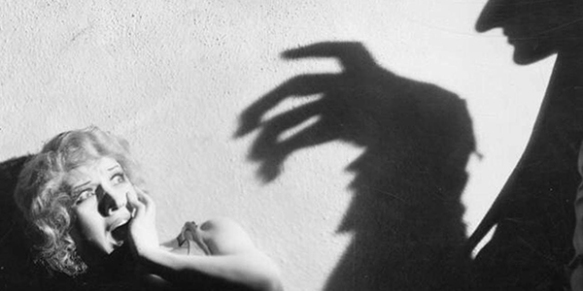










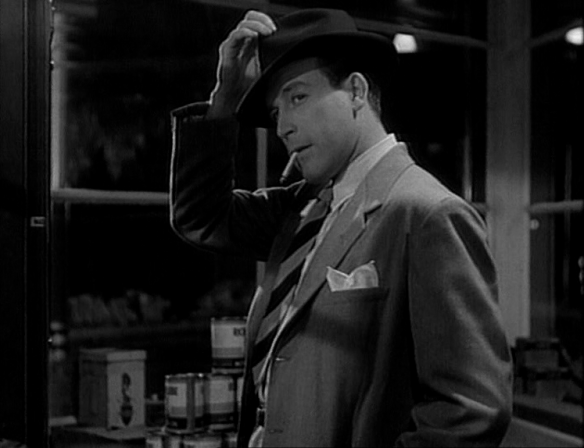

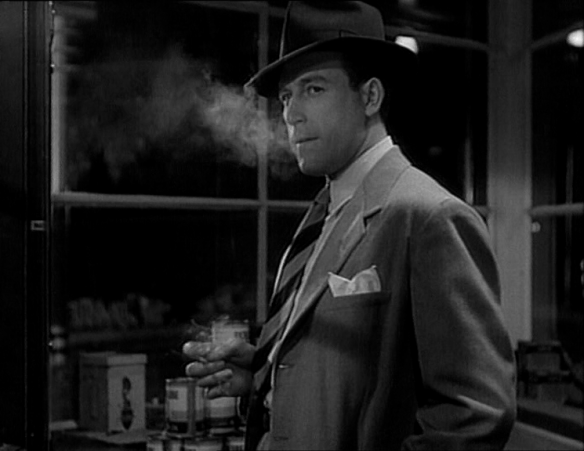

 This is a movie where the bad guy brazenly runs over a cop then convinces his three passengers to roll with that, because he’s just a poor misunderstood soul, see? A movie where the psycho-killer has to take a break from assaulting someone to scrub a liquor stain off the rug while pouting like a scolded little boy. Where a life-or-death warning is scribbled on a piece of paper torn from a hideously racist novelty notepad in a sleazy beach house. Where the good-time gal briefly checks out from the movie to read Balzac (tee-hee!) in her pajamas then exclaims, “Well, I’ll be a monkey’s uncle,” upon learning that someone has been brutally slain. Like I said: icky.
This is a movie where the bad guy brazenly runs over a cop then convinces his three passengers to roll with that, because he’s just a poor misunderstood soul, see? A movie where the psycho-killer has to take a break from assaulting someone to scrub a liquor stain off the rug while pouting like a scolded little boy. Where a life-or-death warning is scribbled on a piece of paper torn from a hideously racist novelty notepad in a sleazy beach house. Where the good-time gal briefly checks out from the movie to read Balzac (tee-hee!) in her pajamas then exclaims, “Well, I’ll be a monkey’s uncle,” upon learning that someone has been brutally slain. Like I said: icky.




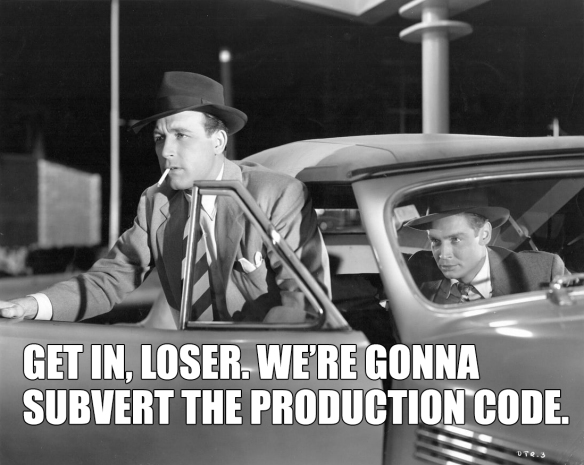



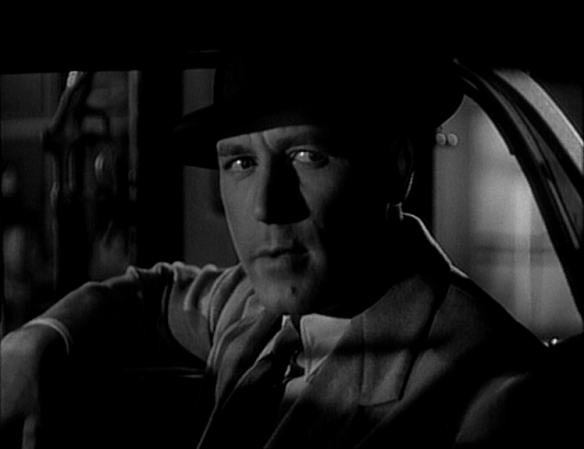 Steve stands in stark contrast to the two cloyingly domestic men who round out the main cast: Fergie, a devoted married man, and Jack, the boyish gas station attendant who proudly displays a photo of his little daughter. (A photo which Steve cruelly mocks: “With those ears, it won’t be long before she can fly.”) Bookended by these happy hubbies, our resident psychopath comes across as the return of a collectively repressed killer instinct. After all, when you ship out thousands and thousands of men to shoot people in a strange land for a few years, not all of them can come home and settle down to become a Fergie or a Jack. There are bound to be complications.
Steve stands in stark contrast to the two cloyingly domestic men who round out the main cast: Fergie, a devoted married man, and Jack, the boyish gas station attendant who proudly displays a photo of his little daughter. (A photo which Steve cruelly mocks: “With those ears, it won’t be long before she can fly.”) Bookended by these happy hubbies, our resident psychopath comes across as the return of a collectively repressed killer instinct. After all, when you ship out thousands and thousands of men to shoot people in a strange land for a few years, not all of them can come home and settle down to become a Fergie or a Jack. There are bound to be complications.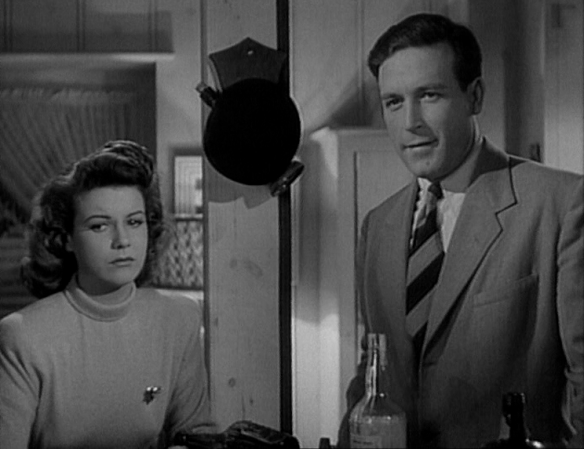

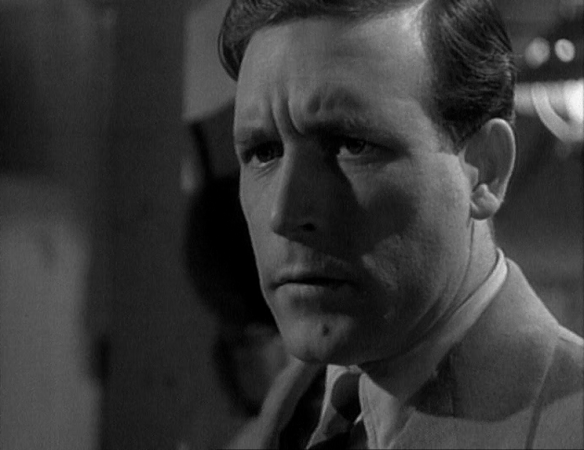


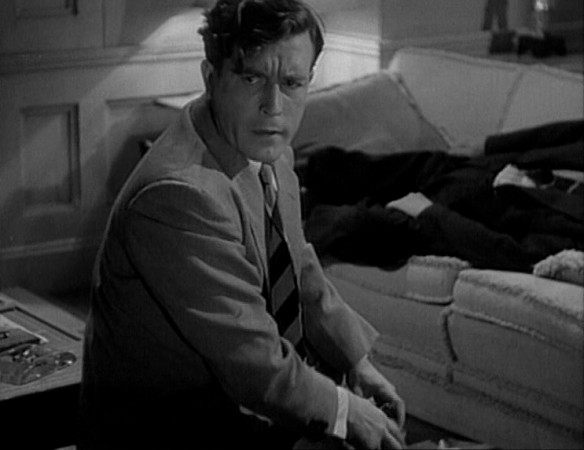


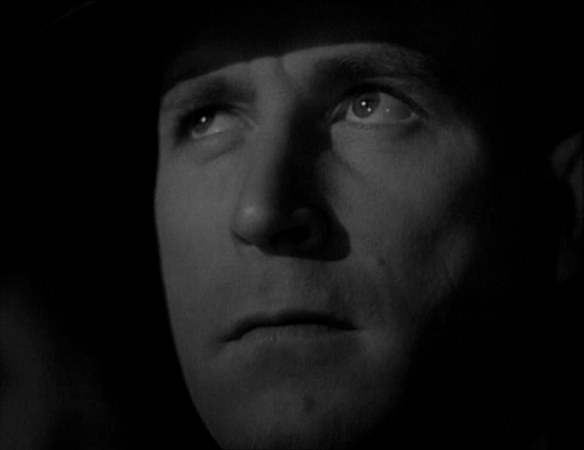

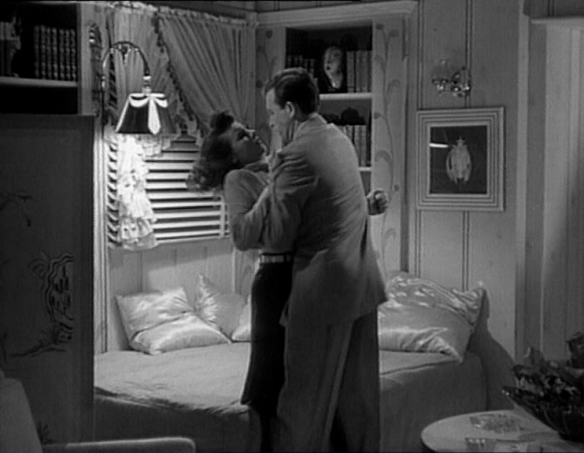
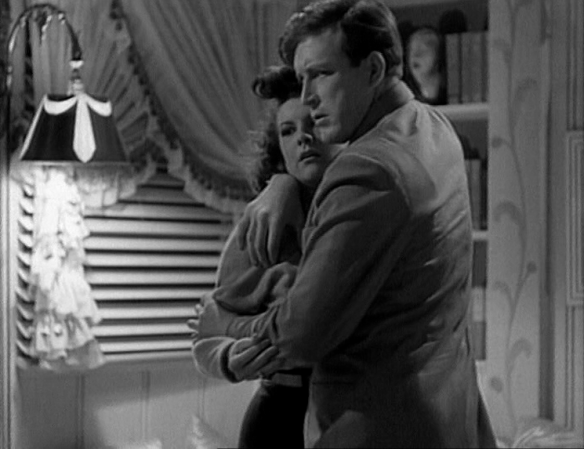




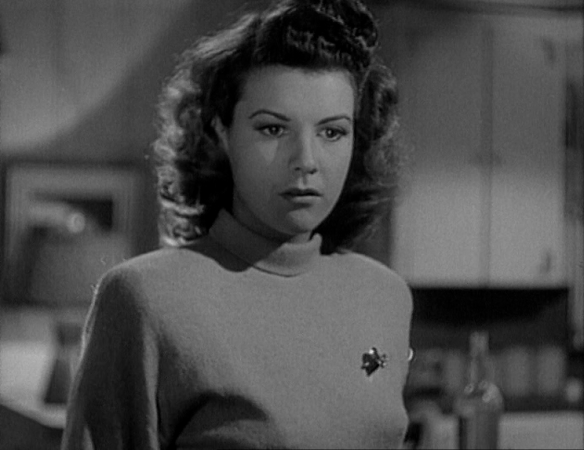






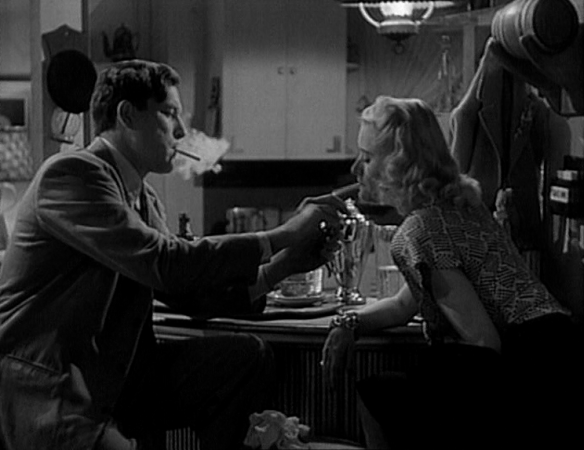

 Where can you see it? The Devil Thumbs a Ride is not currently available on a legit Region 1 DVD. I shelled out for the Region 2 Spanish DVD. It’s crisper and much easier on the eyes than some of the pixelated DVR-ed prints around the internet. The screenshots in this post show what that DVD looks like (though I color-corrected the bluish tint).
Where can you see it? The Devil Thumbs a Ride is not currently available on a legit Region 1 DVD. I shelled out for the Region 2 Spanish DVD. It’s crisper and much easier on the eyes than some of the pixelated DVR-ed prints around the internet. The screenshots in this post show what that DVD looks like (though I color-corrected the bluish tint).